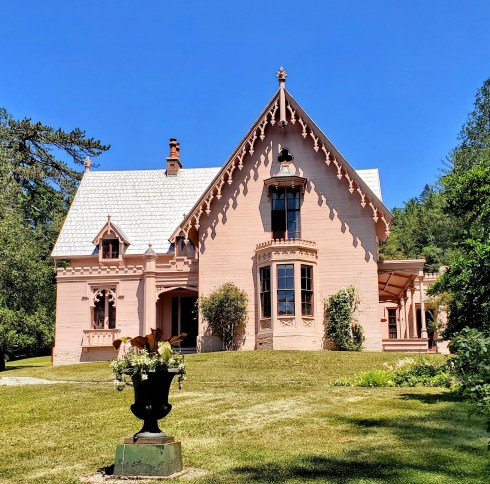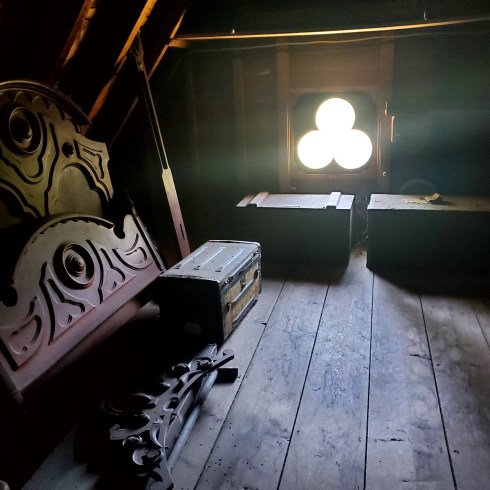Another week: another pink Gothic Revival house! If you haven’t noticed, I’ve been on a Gothic Revival kick for a while. It’s a style you can’t help but notice, and Salem is fortunate to have some notable examples, but I think it was spending a couple of weeks last summer in the Hudson River Valley, a crucible of Gothic creation, which rejuvenated my interest. I saw Lyndhurst and Sunnyside there, along with many other romantic structures and motifs. There are wonderful Gothic Revival buildings in New England as well, and after I saw the Rotch house in New Bedford on my spring break I knew I wanted to see more, so it was off to see Kingscote in Newport, and Roseland Cottage just a few weeks ago. Now I have a long list of houses that I want to visit or revisit, including one with which I thought I was familiar: the Justin Morrill Homestead in Strafford, Vermont. I lived in this village as a child while my father was beginning his academic caeer at Dartmouth, and I remember running all around the estate in the summers: it was irresistable because it was pink, and the site of multiple outbuildings (also pink) which were the source of countless made-up stories and scenarios as well as a mystical, seemingly bottomless, pond. My childhood focus was much more on the grounds than the house, though I have been in the house a couple of times since then, but not with my current Gothic Revival gaze. So this past GLORIOUS weekend, my husband and I drove up to Stafford, where a pink quatrefoiled fence marks the entrance to the Morrill house and grounds.







This was the home of Justin Morrill (1810-1898), or I should say the summer home, as after he made his fortune he began a life of public service which placed him in Washington from 1855 until his death. He served as a US Representative from 1855-1867, and then Senator from 1867 until 1898. Unlike so many of today’s Washington politicians, Morrill was an actual lawmaker, distinguished first and foremost as the crafter of the 1862 Morrill Land Grant College Act which provided federal funding to establish public universities in every state, but he was also (again, notably different than today’s “public” servants) a remarkably effective committee chair, serving in that capacity for the House Ways and Means Committee during the Civil War and for the Joint Committee on Public Buildings thereafter, as well as on the Senate Finance Committee. He financed the Civil War and the completion of the US Capitol! This pastoral pink cottage must have been a welcome sanctuary for the very busy Morrill, and it was very much his house, completed just before his marriage to Ruth Barrell Swan of Easton, Massachusetts in 1851. Just as I had never really considered his house, I had not thought much about Morrill himself until my re-visit this weekend, but both of our guides, John for the exterior and grounds and Eli for the interior, were clearly both very much fans as well as purveyors of lots of detailed information about the Senator and his family. The house is also rather intimate, much more of a cottage rather than a mansion, and it is furnished with items taken from the Morrill home in Washington, so it feels as if you are visiting a home rather than a museum, albeit a home fixed in a particular place and time.















Interiors of the Morrill Homestead: some Gothic Revival orientation, including the Brooks House in Salem; the family (+dog) on the porch, pantry, downstairs hallway, Gothic door details, monogrammed china, the parlor, a downstairs bedroom, stained glass in the Senator’s study, second-floor landing, hallway, and back bedroom, attic details.
And now for some magic! The house has these amazing painted window screens clearly visible from the outside as European-esque landscapes in shades of grey and black, but inside you see only the mesh screen! I have seen painted window screens in Baltimore before, but never in New England. They seemed magical to me, as magical as the ice pond on the estate USED to seem to me as a child: surrounded by trees, you came upon it as a secret, dark place, and again, it was seemingly bottomless. But this weekend, cleared of about half of its guardian trees, it seemed very much like just a pond. In fact, that’s what my husband said to me: “it’s just a pond, Donna.” I couldn’t even take a good photo of it as it was so sunny, sorry. An older photograph conveying the dark and magical qualities it possessed in my childhood mind is also elusive: just imagine a black hole!




The Justin Morrill Historic Site is one of ten historic sites and National Historic Landmarks owned and maintained by the state of Vermont through its Division for Historic Preservation with the active support of the Friends of the Morrill Homestead. All the essential information about visiting the Morrill Homestead is at the Friends’ website, as well as evidence of their very active interpretation of the site: https://www.morrillhomestead.org/. Special thanks to John Freitag who gave us such a great tour, but also gave me a very substantive historical answer to a question I’ve long wondered about the Strafford Town House (below): why such a large structure for such a small village? Of course it’s all about the local politics of the American Revolution—and after.






